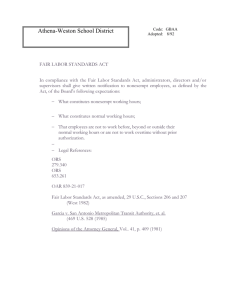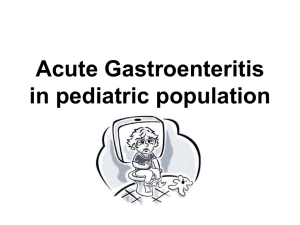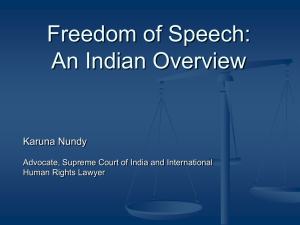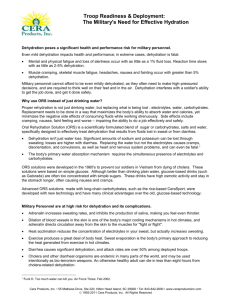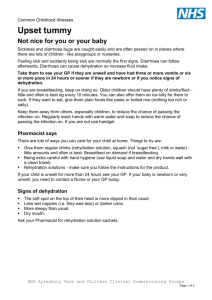Oral Rehydration Therapy vs IV Therapy in US
advertisement
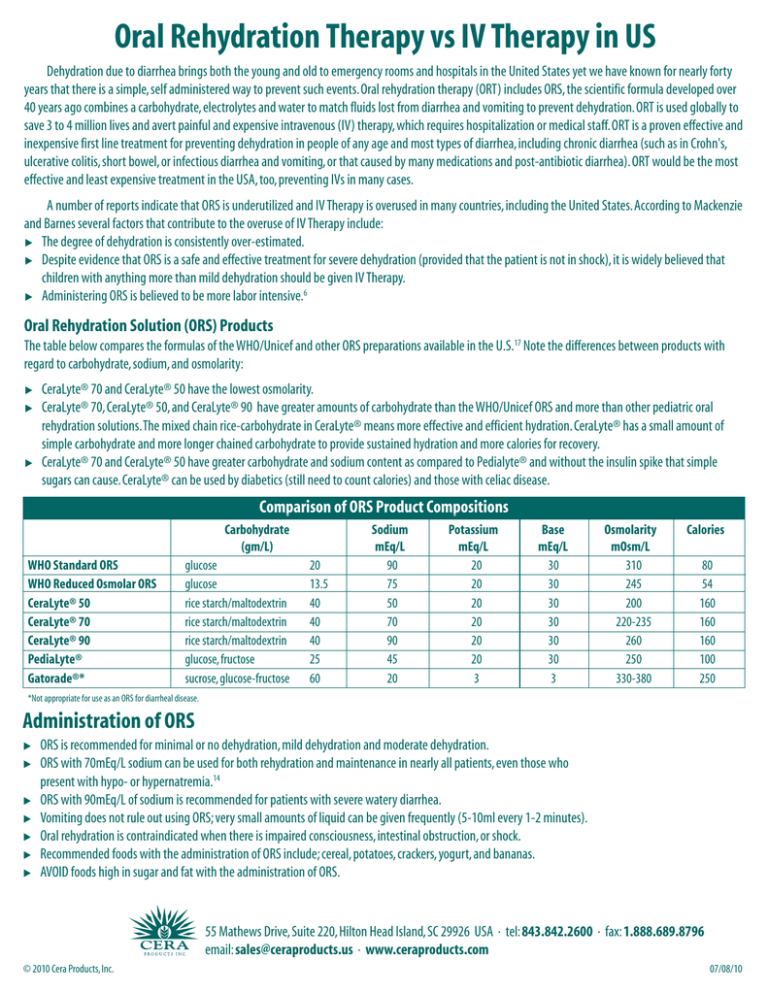
Oral Rehydration Therapy vs IV Therapy in US Dehydration due to diarrhea brings both the young and old to emergency rooms and hospitals in the United States yet we have known for nearly forty years that there is a simple, self administered way to prevent such events. Oral rehydration therapy (ORT) includes ORS, the scientific formula developed over 40 years ago combines a carbohydrate, electrolytes and water to match fluids lost from diarrhea and vomiting to prevent dehydration. ORT is used globally to save 3 to 4 million lives and avert painful and expensive intravenous (IV) therapy, which requires hospitalization or medical staff. ORT is a proven effective and inexpensive first line treatment for preventing dehydration in people of any age and most types of diarrhea, including chronic diarrhea (such as in Crohn's, ulcerative colitis, short bowel, or infectious diarrhea and vomiting, or that caused by many medications and post-antibiotic diarrhea). ORT would be the most effective and least expensive treatment in the USA, too, preventing IVs in many cases. A number of reports indicate that ORS is underutilized and IV Therapy is overused in many countries, including the United States. According to Mackenzie and Barnes several factors that contribute to the overuse of IV Therapy include: 왘 The degree of dehydration is consistently over-estimated. 왘 Despite evidence that ORS is a safe and effective treatment for severe dehydration (provided that the patient is not in shock), it is widely believed that children with anything more than mild dehydration should be given IV Therapy. 왘 Administering ORS is believed to be more labor intensive.6 Oral Rehydration Solution (ORS) Products The table below compares the formulas of the WHO/Unicef and other ORS preparations available in the U.S.17 Note the differences between products with regard to carbohydrate, sodium, and osmolarity: 왘 왘 왘 CeraLyte® 70 and CeraLyte® 50 have the lowest osmolarity. CeraLyte® 70, CeraLyte® 50, and CeraLyte® 90 have greater amounts of carbohydrate than the WHO/Unicef ORS and more than other pediatric oral rehydration solutions. The mixed chain rice-carbohydrate in CeraLyte® means more effective and efficient hydration. CeraLyte® has a small amount of simple carbohydrate and more longer chained carbohydrate to provide sustained hydration and more calories for recovery. CeraLyte® 70 and CeraLyte® 50 have greater carbohydrate and sodium content as compared to Pedialyte® and without the insulin spike that simple sugars can cause. CeraLyte® can be used by diabetics (still need to count calories) and those with celiac disease. Comparison of ORS Product Compositions Carbohydrate (gm/L) WHO Standard ORS WHO Reduced Osmolar ORS CeraLyte® 50 CeraLyte® 70 CeraLyte® 90 PediaLyte® Gatorade®* glucose glucose rice starch/maltodextrin rice starch/maltodextrin rice starch/maltodextrin glucose, fructose sucrose, glucose-fructose 20 13.5 40 40 40 25 60 Sodium mEq/L 90 75 50 70 90 45 20 Potassium mEq/L 20 20 20 20 20 20 3 Base mEq/L 30 30 30 30 30 30 3 Osmolarity mOsm/L 310 245 200 220-235 260 250 330-380 Calories 80 54 160 160 160 100 250 *Not appropriate for use as an ORS for diarrheal disease. Administration of ORS 왘 왘 왘 왘 왘 왘 왘 ORS is recommended for minimal or no dehydration, mild dehydration and moderate dehydration. ORS with 70mEq/L sodium can be used for both rehydration and maintenance in nearly all patients, even those who present with hypo- or hypernatremia.14 ORS with 90mEq/L of sodium is recommended for patients with severe watery diarrhea. Vomiting does not rule out using ORS; very small amounts of liquid can be given frequently (5-10ml every 1-2 minutes). Oral rehydration is contraindicated when there is impaired consciousness, intestinal obstruction, or shock. Recommended foods with the administration of ORS include; cereal, potatoes, crackers, yogurt, and bananas. AVOID foods high in sugar and fat with the administration of ORS. 55 Mathews Drive, Suite 220, Hilton Head Island, SC 29926 USA · tel: 843.842.2600 · fax: 1.888.689.8796 email: sales@ceraproducts.us · www.ceraproducts.com © 2010 Cera Products, Inc. 07/08/10 Current Guidelines and Recommendations for Patients with Acute Gastroenteritis Minimal to No Dehydration Phase I Fluid Replacement Initial rehydration is unnecessary Phase II Maintenance <10 kg BW 60-120ml per Diarrheal Stool or Vomiting Episode >10kg BW 120-240ml/kg per Diarrheal Stool or Vomiting Episode *BW = Body Weight Mild Dehydration (3-5% fluid loss) ORS should be initiated with 50ml/kg and 100mg/kg, respectively, over a 3-4 hour period -Thirst is best guide for alert patients -When nausea/vomiting are present: 10ml/kg of ORS/loose stool -The amount of fluid being lost should be replaced4,13 Moderate Dehydration (6-9% fluid loss) ORS should be initiated with 50ml/kg and 100mg/kg, respectively, over a 3-4 hour period -Thirst is best guide for alert patients -When nausea/vomiting are present: 10ml/kg of ORS/loose stool -The amount of fluid being lost should be replaced4,13 Severe Dehydration (6-9% fluid loss) Ringers Lactate IV (20ml/kg)** **When mental status improves ORS can be given (100ml/kg) over 4 hours or D5½NS can be given intravenously. 4 Benefits of Rice-Based Oral Rehydration Therapy 왘 왘 왘 왘 왘 Cost Effective (IV vs.Oral) Lack of Complications Lack of Pain Provides calories from complex carbohydrates Less worry when mixing because rice-based ORS has a lower osmolarity then glucose-based ORS 왘 왘 왘 왘 Lower osmolarity also means better absorption Always works as well as glucose-based ORS and is even more effective in severe cases of dehydration Sustained hydration (larger molecule, more substrate) Tastes better In summary, dehydration remains a significant problem in the United States. Oral Rehydration Therapy is an effective, inexpensive and simple-to-use treatment for patients suffering from dehydration. The administration of ORS can improve the health and well-being of individuals suffering from diarrheal illness, vomiting and other conditions that lead to dehydration, such as Crohn’s, ulcerative colitis, short-gut, or medications for cancer or HIV/AIDS treatments or other medications, including antibiotics, that may lead to diarrhea. When choosing an ORS product, CeraLyte® is superior to others. While glucose-based ORS preparations appear to be at least as effective as IV rehydration, CeraLyte® rice-based ORS has the advantage of low osmolarity with more carbohydrates for more efficient hydration without sacrificing electrolyte content. CeraLyte’s patented ricebased ORS does not contain added sugars for sustained, effective hydration. ORS Treatment—Proven Safe, Cost-Effective In a 1986 study, infants with acute gastroenteritis were randomly assigned to receive ORS or intravenous rehydration. This study, according to the author, demonstrated that oral rehydration is a safe and cost-effective means of treating dehydrated infants in an emergency department holding room.5 A randomized trial was conducted in 52 Australian children given rehydration fluids by mouth or via nasogastric administration and another 52 children were given rehydration intravenously. It was concluded that rehydration by mouth or nasogastric tube is safe and effective for the treatment of moderately dehydrated children with gastroenteritis.6 In a randomized controlled trial in an urban emergency department, investigators compared ORS with IV therapy for the treatment of moderate dehydration in children with acute gastroenteritis. From this study perceived barriers for the use of ORS were not supported by the evidence, as oral rehydration performed better than IV therapy on all measured outcomes.7 In another meta-analysis of 16 trials involving 1545 children and conducted in 11 countries, those treated with oral rehydration had significantly fewer major adverse events, including seizures or death (relative risk 0.36), and a significant reduction in length of hospital stay (mean 21 hours). 8 References 1. Water with sugar and salt. Lancet 1974; 2:200-301 2. Greenough WB III.The human, societal, and scientific legacy of cholera. J Clin Invest 2004;113:334-39 3. Santosham M. Oral rehydration therapy for diarrhea: an example of reverse transfer of technology. Pediatrics 1997;100(5):e10 4. Centers for Disease Control and Prevention. Managing acute gastroenteritis among children: oral rehydration, maintenance, and nutritional therapy. MMWR 2003;52(No. RR-16):1-16 5. Listernick R, Zieserl E, Davis T. Outpatient oral rehydration in the United States.Arch Pediatr Adolesc Med 1986;140:211-15 6. MacKenzie A, Barnes G. Randomised controlled trial comparing oral and intravenous rehydration therapy in children with diarrhea. BMJ 1991;303:393-96 7. Atherly-John YC, Cunningham SJ, Crain EF. A Randomized trial of oral vs intravenous rehydration in a pediatric emergency department. Arch Pediatr Adolesc Med. 2002;156:1240-43 8. Fonseca BK, Holdgate A, Craig JC. Enteral vs intravenous rehydration therapy for children with gastroenteritis; a metaanalysis of randomized controlled trials. Arch Pediatr Adolesc Med. 2004;158:483-490 9. Spandorfer PR, Alessandrini EA, Joffe MD, Localio R. Oral versus intravenous rehydration of moderately dehydrated children: a randomized, controlled trial. Pediatrics 2005;115:295-301 10. Santosham M. Oral rehydration therapy: reverse transfer of technology (editorial). Arch Pediatr Adolesc Med 2002;156:1177-79 11. Ladinsky M, Goepp J, Santosham M, Meyers A. Outpatient oral rehydration. Ann Emerg Med 1997;29:551-53 12. Reis EC, Goepp JG, Katz S, Santosham M.Barriers to use of oral rehydration. Pediatrics 1994;93:708-11 © 2010 Cera Products, Inc. 13. Santosham M, Greenough WB III. Oral rehydration therapy: a global perspective. J Pediatr 1991;118(suppl):S44-S51 14. Ozuah PO, Avner JR, Stein REK. Oral rehydration, emergency physicians, and practice parameters: a national survey. Pediatrics 2002;109:259-61 15. Rabbani GH.The search for a better oral rehydration solution for cholera. NEJM 2000;342:345-47 16. Field M. Intestinal ion transport and the pathophysiology of diarrhea. J Clin Invest 2003;111:931-43 17. Kelly DG, Nadeau J. Oral rehydration solution: a “low-tech” oft neglected therapy. Practical Gastroenterology 2004;27:51-62 18. Faes MC, Spigt MG, Rikkert MGM. Dehydration in Geriatrics. Geriatrics Aging 2007;10:590-96 19. Xiao H, Barber J, Campbell ES. Economic burden of dehydration among hospitalized elderly Patients. Am j Health-Syst Pharm 2004;61:2534-40 20. Zavaleta N, Figueroa D, Rivera J, Sanchez J, Alfaro S, Lonnerndal B. Efficacy of Rice-based Oral Rehydration Solution Containing Recombinant Human Lactoferrin and Lysozyme in Peruvian Children with Acute Diarrhea. J Ped Gastro and Nutr 2007; 44:258-264. 21. Carpenter CCJ, Greenough WB, Pierce N. Oral-rehydration therapy – The Role of Polymeric Substrates. NE J Med Nov 17, 1988, 319 No 20; 1346-48. 22. Field M. New Strategies for Treating Watery Diarrhea. NE J Med. Nov 17, 1977; 297 No 20; 1121-23. 23. Hirschhorn N, Greenough WB III. Progress in Oral Rehydration Therapy. Scientific American. May 1991; 50-56. 24. Murphy CK, Hahn S, Volmick J. Reduced osmolarity oral rehydration solution for treating cholera (review). The Cochrane Collection. Wiley & Sons LTD. 2009;1-38. 55 Mathews Drive, Suite 220, Hilton Head Island, SC 29926 USA · tel: 843.842.2600 · fax: 1.888.689.8796 email: sales@ceraproducts.us · www.ceraproducts.com 07/08/10
